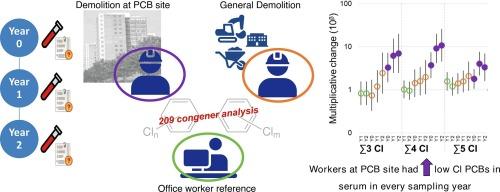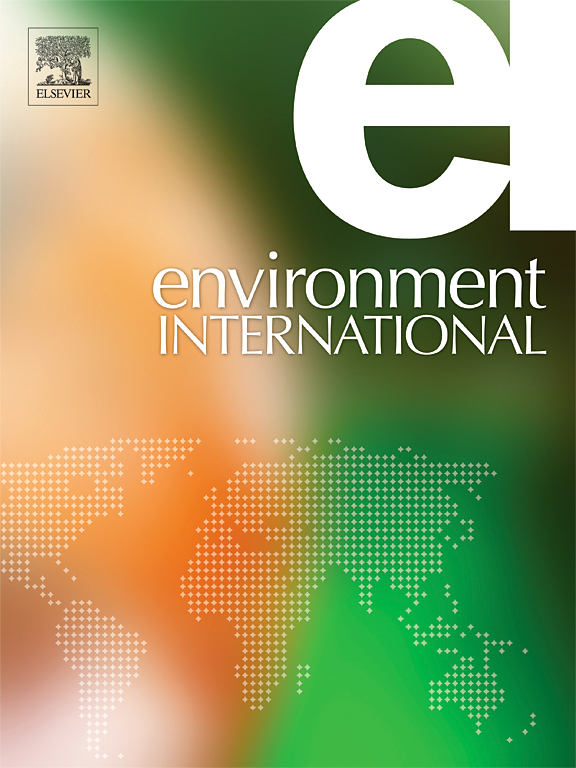Lower chlorinated PCBs accumulate in demolition workers while working on a contaminated worksite
IF 10.3
1区 环境科学与生态学
Q1 ENVIRONMENTAL SCIENCES
引用次数: 0
Abstract
Several buildings in a Danish social housing estate exceeded indoor air guidance values for polychlorinated biphenyls (PCBs), leading to their demolition. Here, we conducted a biomonitoring study among the workers on-site (n = 24) to evaluate their exposure to all 209 PCBs across the two-year demolition. We compared their PCB serum concentrations and accumulation to those of demolition workers at other worksites (n = 21) and office workers (n = 17). Demolition workers were provided with personal protective equipment according to risk assessments for PCB-related work. Serum PCBs were measured from baseline and up to two annual follow-up visits using gas chromatography high-resolution mass spectrometry. Forty-six peaks representing 58 PCBs were detected in > 60 % of serum samples; eight congeners were found in every sample. PCB-153 was the most abundant congener (median = 22.1 ng/g lipid). After adjusting for age and smoking status, demolition workers after one year on the contaminated site experienced more than a four-fold increase in all lower chlorinated PCBs compared to office workers at baseline, with increases most prominent for tri- and tetra-CBs (10β = 6.2 and 9.2, p < 0.01). Nine PCBs were significantly elevated from baseline to year 1 in only contaminated-site demolition workers, with the largest increase observed for PCB-66/80. For higher chlorinated PCBs, levels remained consistent or decreased slightly over the three samples from these workers. Those who worked in active demolition for at least 4 years at baseline experienced a 40 % increase (95 % CI: 10 %, 90 %) in the WHO-12 PCB sum. Age significantly predicted increases in PCBs, which tracked closely with logKow values. Our study showed that despite safety measures, demolition workers who worked on a PCB-contaminated site experienced increased and accumulating internal exposure to lower chlorinated PCBs compared to general demolition and office workers. Consequently, workers’ safety should be carefully considered to reduce exposures among this high risk group.


在受污染的工地工作时,拆除工人体内积累的氯化多氯联苯含量较低
丹麦一个社会住宅区的几栋建筑室内空气中的多氯联苯 (PCB) 含量超过了指导值,导致这些建筑被拆除。在此,我们对现场工人(n = 24)进行了一项生物监测研究,以评估他们在为期两年的拆除过程中接触所有 209 种多氯联苯的情况。我们将他们血清中的多氯联苯浓度和累积量与其他工地的拆迁工人(21 人)和办公室工人(17 人)进行了比较。根据多氯联苯相关工作的风险评估,为拆除工人提供了个人防护设备。使用气相色谱高分辨质谱法测量了基线和两次年度随访的血清多氯联苯含量。在 60% 的血清样本中检测到了代表 58 种多氯联苯的 46 个峰值;在每个样本中都发现了 8 种同系物。PCB-153 是含量最高的同系物(中位数 = 22.1 纳克/克脂质)。在对年龄和吸烟状况进行调整后,与基线时的办公室工作人员相比,在受污染场地工作一年后的拆除工人的所有低氯化多氯联苯含量增加了四倍多,其中三氯和四氯多氯联苯的增加最为显著(10β = 6.2 和 9.2,p < 0.01)。从基线到第 1 年,只有受污染现场的拆除工人体内的 9 种多氯联苯出现了明显升高,其中 PCB-66/80 的升高幅度最大。对于氯化程度较高的多氯联苯,在这些工人的三个样本中,其含量保持一致或略有下降。在基线期至少从事过 4 年拆迁工作的工人,其 WHO-12 多氯联苯总和增加了 40%(95% CI:10%,90%)。年龄在很大程度上预示着多氯联苯的增加,这与 logKow 值密切相关。我们的研究表明,尽管采取了安全措施,但与一般的拆迁工人和办公室工人相比,在受多氯联苯污染的工地工作的拆迁工人体内接触到的低氯化多氯联苯会增加并不断累积。因此,应认真考虑工人的安全问题,以减少这一高风险群体的暴露量。
本文章由计算机程序翻译,如有差异,请以英文原文为准。
求助全文
约1分钟内获得全文
求助全文
来源期刊

Environment International
环境科学-环境科学
CiteScore
21.90
自引率
3.40%
发文量
734
审稿时长
2.8 months
期刊介绍:
Environmental Health publishes manuscripts focusing on critical aspects of environmental and occupational medicine, including studies in toxicology and epidemiology, to illuminate the human health implications of exposure to environmental hazards. The journal adopts an open-access model and practices open peer review.
It caters to scientists and practitioners across all environmental science domains, directly or indirectly impacting human health and well-being. With a commitment to enhancing the prevention of environmentally-related health risks, Environmental Health serves as a public health journal for the community and scientists engaged in matters of public health significance concerning the environment.
 求助内容:
求助内容: 应助结果提醒方式:
应助结果提醒方式:


